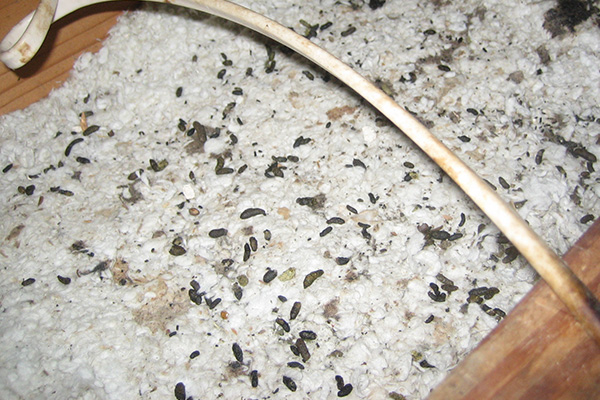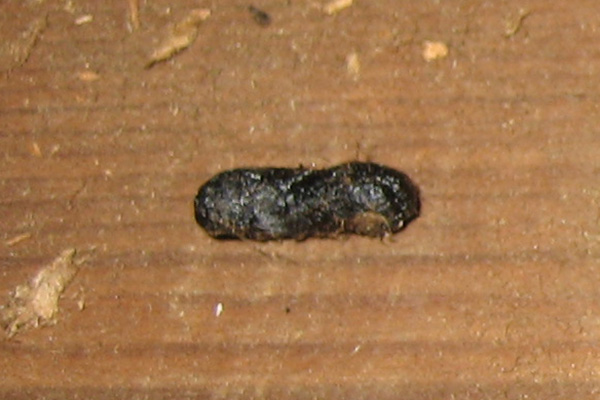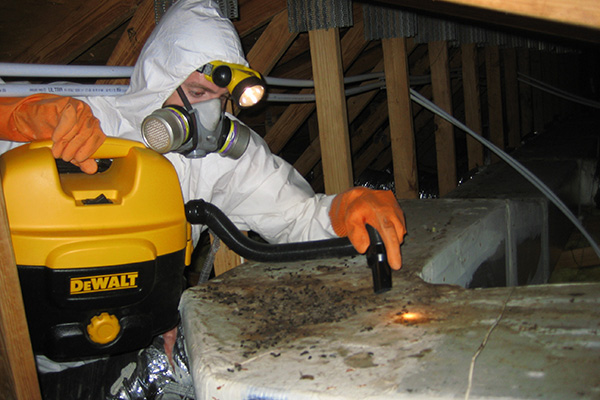- info@animalatticpest.com
- Call - we service 300 locations

Rat Feces in the Attic - Photographs, How to Clean
Of course rats always deficate and urinate in the attic. This can cause odor problems, a breeding ground for mold, is
host to potential pathogens and health risks, and the odor can contain phermonones that attract other rats into the attic. Sometimes the feces or urine can leak through the drywall and onto your ceiling. I have
seen that many times. Be sure not to touch or even disturb rat feces in an attic. It is often a good idea to clean it up, with a full attic restoration.
As for how to identify rat feces (or droppings, poop, scat, turds, latrine, whatever you want to call it), look at the below photographs. The feces are small brown poops, about 1/4 inch in length on average, with
somewhat rounded ends. They are usually scattered instead of in piles, and sometimes the droppings number in the thousands. They often become drier and thus more chalky in appearance with age, but are usually
pretty much dark brown, like your own poo.
Photographs of Rat Feces in Attics
A Trail of Rat Feces
Rats leave their waste where they travel, so a trail like this in the attic is prime rat evidence. This is a good spot to set a trap or two!
Rat Droppings in Insulation
Rats run in the insulation, so often thousands of droppings become embedded in the insulation. Some people elect to have the insulation vacuumed out of the house.
Closeup of a Single Rat Turd
Click the image for a closer look. This is a single dropping from a Roof Rat (rattus rattus), which is the most common type of rat to live in the attic.
Information About Rat Feces in the Attic
How do I clean rat feces out of my attic? If you have found rats in your attic then it is quite likely that, if not outright certain, that you are going to find rat feces laying around all over. Rats are not one to use a designated area to relieve them,
so you will likely find a whole lot of places where there is rat waste.
Now you have the unenviable tasks of cleaning up this waste. You simply can’t leave it laying around. It has to be removed, but before you get all gung-ho about doing so, you should be aware of a few things to protect yourself.
Rats carry a vast amount of diseases and parasites, which means that you need to be careful when you are cleaning their waste. While the rat may not be there any longer, its waste will still contain some of these pathogens, which can be hazardous for you to
touch or breathe in. This means you need to wear a mask and gloves at all times. Better safe than sorry. Read more about specific diseases from rats.
To begin with you will want to get a shop vac and vacuum up the feces. Do not sweep it if at all possible. You may actually cause the parasites to become airborne, which is more dangerous to you. Also a shop vac is much easier to clean than a standard vacuum
because you can run water and bleach through it to clean it out. This is very important, because in your other vacuum the parasites could get in the hoses or the bag area and spread the illnesses over months.
Once you have vacuumed this all up, the next step is to mix together a concoction of hydrogen peroxide, water and ammonia. It should be warm water. While wearing gloves, scrub the all affected areas to make sure that they are cleaned of urine, bacteria and
viruses. You should probably repeat this at least three times, and make sure that you go at least 12 inches in all directions around the waste. Don’t just clean directly where the waste was. Bacteria spread.
If you find that the waste is on or near your insulation this will have to be thrown out in the areas where you find the waste. It is clear that this is very expensive, but your health is not something to be playing around with. You must clean these areas
to keep them safe and ensure that your health is not put at risk in any way from the waste that is around.
The Bottom Line of Rat Poo
To identify the rodent feces in your attic, the best bet is to look at the size. Smaller is rat, larger is rat or squirrel. How to get rid of rat droppings in the attic - the best approach is a full cleanup, with either vacuuming of feces or insulation removal, and fogging of the attic with a special enzyme cleaner. But if your attic isn't too dirty, you may want to skip this expensive step. If you just have some poop in your attic and want to know which animal caused the poop, look at the above images of rat droppings, and you should be able to identify if rats are the culprit.




